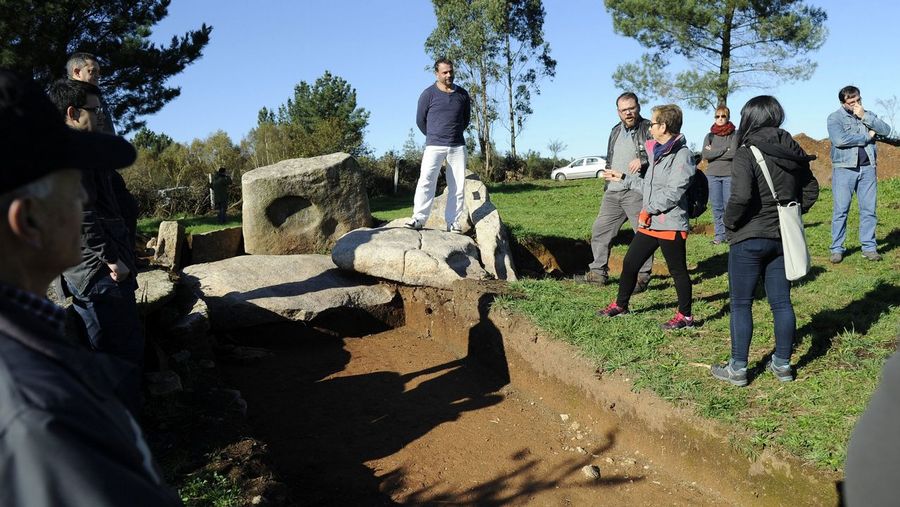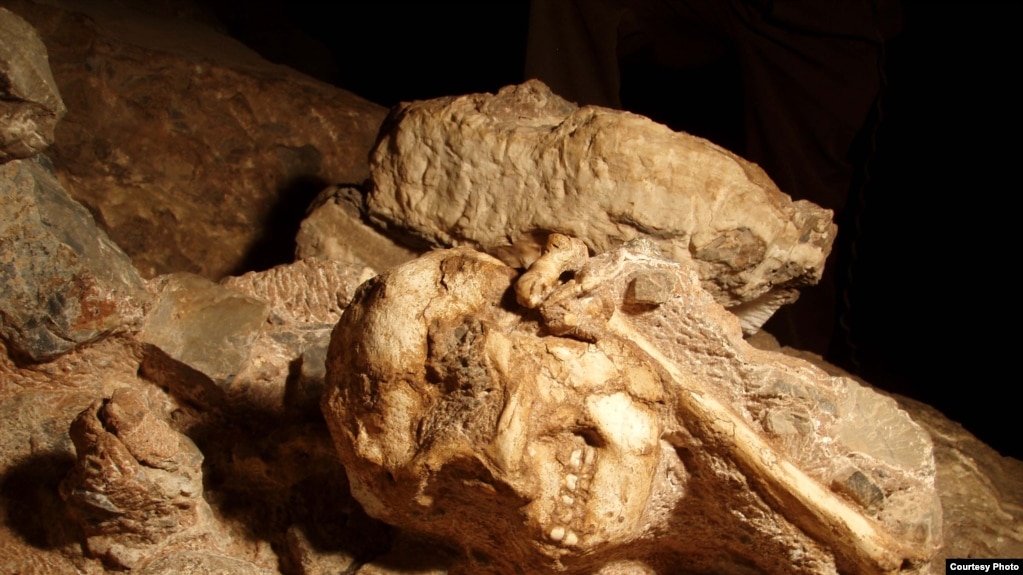Evento.
Viaje a la prehistoria de Formentera - Diario de Ibiza /
Link 2
Este lunes 4 de diciembre, a las 19 h, se inaugura la exposición «La
primera piedra. La Formentera prehistórica a través de sus herramientas»
en el Ajuntament Vell de Formentera. La muestra se podrá visitar hasta
el 16 de diciembre...
Los neandertales del Abric Romaní aplicaban complejas tácticas de cacería - Noticias IPHES
Se ha constatado que cazaban selectivamente los caballos de edad adulta, en cambio, la misma actividad con los ciervos era más variable y, por consiguiente, flexible
Averiguar la edad que tenían los animales cuando
murieron ha proporcionado información muy valiosa sobre el modo de
obtención de los recursos animales (caza o carroña) y sobre las tácticas
empleadas para su captura, las cuales pueden tener un importante
significado social, ya que nos puede permitir inferir la cooperación
entre individuos para hacerse con las presas, saber cómo se
transportaron los cuerpos de los animales y si existía una posterior
distribución de los alimentos entre los individuos que formaban un grupo
de cazadores recolectores...
Canteros prehistóricos de O Porriño
En el valle del río Louro están
documentados algunos de los más antiguos asentamientos humanos de
Galicia que cazaban corzos, ciervos o elefantes
... Pero el negocio de la piedra en A Louriña viene de antiguo. En concreto,
de la época en la que había hipopótamos en el río Miño. Porque en este
valle están documentados algunos de los más antiguos asentamientos
humanos en el actual territorio de Galicia...
Audio.
Orzas del Portillo del Arenal - MVPAC - RTVE.es
Se trata de unas cerámicas de gran tamaño muy frecuentes en la Edad del
Bronce. Su función era almacenar alimentos en grandes cantidades. Las
del
Portillo del Arenal se caracterizan por su buen estado de
conservación...
Más sobre Anulada la venta de un valioso yacimiento arqueológico de Vilalba
El delegado de Hacienda en Lugo firmó ayer la resolución para sacar de una puja el área de Pena Grande...
Los cuentacuentos aglutinaron a los humanos antes de la religión
/
Link 2
La narración de cuentos promovió la cooperación entre cazadores-recolectores antes del advenimiento de la religión organizada, según revela un nuevo estudio de 'University College London' (UCL).
La investigación muestra que los narradores de cazadores-recolectores fueron esenciales en la promoción de valores cooperativos e igualitarios antes de que se desarrollaran mecanismos comparables en las sociedades agrícolas más grandes, como la moralización de grandes dioses.
Los narradores de cuentos también eran más populares que los mejores recolectores, tenían un mayor éxito reproductivo y eran más propensos a contar con la cooperación de otros miembros del campamento, según las conclusiones de esta investigación, que se detallan en
un artículo publicado este martes en 'Nature Communications'...
Exponen esqueleto humano de hace 3.6 millones de años | Excélsior
Los restos fósiles pertenecen a un
Australopithecus, al que apodaron 'Little Foot', es el más completo que
se ha encontrado hasta el momento; tardaron 20 años en excavar y
reconstruir la estructura
La Universidad de Witwatersrand exhibió el miércoles los restos óseos prácticamente completos del fósil catalogado como Australopithecus.
El esqueleto data de 3,6 millones de años y su descubrimiento ayudará a los expertos a entender cómo se veía y movía este ancestro de la raza humana.
Los académicos explicaron que tardó 20 años excavar, limpiar, reconstruir y analizar la estructura ósea.
El esqueleto, apodado Pie Pequeño (Little Foot), fue descubierto en las cuevas de Sterkfontein, en las afueras de Johannesburgo, cuando unos mineros se toparon con fragmentos de huesos al excavar en la zona.
El profesor Ron Clarke y sus asistentes hallaron los fósiles y se tomaron años en el proceso de excavar, analizar y reconstruir el esqueleto.
El descubrimiento es causa de orgullo para los africanos, dijo Robert Blumenschine, principal científico de la organización que financió las excavaciones, Paleontological Scientific Trust (PAST)...
Otorgan premio internacional al Proyecto Arqueológico Subacuático del INAH | La Crónica de Hoy
El Proyecto Arqueológico Subacuático Hoyo Negro, Tulum, Quintana Roo, que lleva a cabo desde 2011 la Subdirección de Arqueología Subacuática del Instituto Nacional de Antropología e Historia (INAH), recibirá el 8 de diciembre el Premio Descubrimiento en Campo, que otorga el Shanghai Archaeology Forum (SAF, Foro Arqueológico de Shanghai) de la Academia China de Ciencias Sociales de China...
---
Creuser au Mésolithique / Digging in the Mesolithic - Société Préhistorique française
Actes de la séance de la Société préhistorique française de Châlons-en-Champagne (29-30 mars 2016).
Tous les fichiers sont en accès libre...
Vídeos. Les conférences de Lascaux
Destinées à apporter des éclairages sur diverses thématiques autour de
l'art pariétal, les conférences proposées à Lascaux Centre International
s'adressent à tout public : enseignants, étudiants, chercheurs...
Evento.
Gibraltar Museum Christmas Lecture: Bringing Our Ancestors back to Life
The Gibraltar Museum Annual Christmas Lecture takes place this Thursday, 7th December, at 7pm at the John Mackintosh Hall.
This year’s speaker is world famous Paleoartist Mauricio Anton who will be delivering a lecture entitled
Bringing Our Ancestors back to Life...
New approach measuring early butchering practices can help answer questions about evolution - Purdue University
Researchers, led by a Purdue University anthropology professor, have found that statistical methods and 3D imaging can be used to accurately measure animal bone cut marks made by prehistoric human butchery, and to help answer pressing questions about human evolution.
Archaeologist and biostatistician Erik Otárola-Castillo leads the research team that used 3-D imaging, shape analysis and Bayesian statistics to identify butchery cut marks with an 88 percent success rate in classifying butchery behaviors. The 3-D imaging technology is similar to what engineers use to measure scratches on microchips and surgical blade sharpness...
Storytellers promoted co-operation among hunter-gatherers before advent of religion
Storytelling promoted co-operation in hunter-gatherers prior to the advent of organised religion, a new UCL study reveals.
The research shows that hunter-gatherer storytellers were essential in promoting co-operative and egalitarian values before comparable mechanisms evolved in larger agricultural societies, such as moralising high-gods.
Storytellers were also more popular than even the best foragers, had greater reproductive success, and were more likely to be co-operated with by other members of the camp, according to the research published today in Nature Communications... (
Vídeo*)
*
Vídeo Cooperation and the Evolution of Hunter-Gatherer Storytellers añadido a
PaleoVídeos > L.R.2.14 nº 45.
Little Foot takes a bow - Wits University
After 20 years of painstaking excavation and preparation, Professor Ron Clarke introduces the most complete Australopithecus fossil ever found to the world.
South Africa’s status as a major cradle in the African nursery of humankind has been reinforced with today’s unveiling of “Little Foot”, the country’s oldest, virtually complete fossil human ancestor. Little Foot is the only known virtually complete Australopithecus fossil discovered to date. It is by far the most complete skeleton of a human ancestor older than 1.5 million years ever found. It is also the oldest fossil hominid in southern Africa, dating back 3.67 million years... (
Vídeo*)
*
Vídeo Introducing Little foot añadido a
PaleoVídeos > L.R.2.14 nº 46.
Archaeologists revise chronology of the last hunter-gatherers in the Near East – University of Copenhagen
New research by a team of scientists and archaeologists based at the Weizmann Institute of Science and the University of Copenhagen suggests that the 15,000-year-old ‘Natufian Culture’ could live comfortably in the steppe zone of present-day eastern Jordan - this was previously thought to be either uninhabitable or only sparsely populated...
Excavations show ancient contact with neighbours - Cyprus Mail
During this season’s excavations at the multi-period site of Prastio-Mesorotsos in the Paphos district a number of shallow pits were found many containing broken objects placed in a ritualistic manner, including stone vessels, human remains and a fragment of an anthropomorphic clay figurine.
The discovery of a rare stone-shaped engraved object confirmed that the site was in use during the Aceramic Neolithic period. These engraved stone objects have also been found in the neighbouring location of Choletria-Ortos, Choirokitia and Lebanon. Although their use has not yet been established, these objects reveal contact between Cyprus and inhabitants of other coasts at a time when the island’s special Neolithic culture is thought to have been developed...
Vídeo. Evidence Suggests Stonehenge Was an Elite Cemetery - Smithsonian Channel
From the Series: Secrets: Stonehenge Mystery
http://bit.ly/2iswl5I
Ver en
PaleoVídeos > L.R.2.14 nº 44.
Vídeo. Living with gods: the 40,000-year-old Lion Man - British Museum Curator Jill Cook introduces the 40,000-year-old
sculpture of lion man. A figure made of mammoth ivory with the body of a man and the head of a cave lion.
Ver en
PaleoVídeos > L.R.2.14 nº 47.
Más noticias / More news













